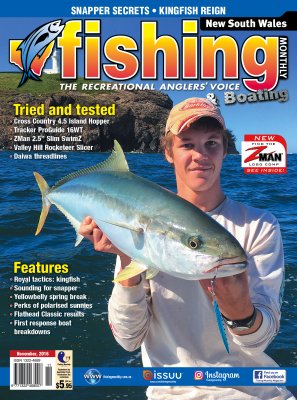Spring time yellowbelly by Chris Frith
 Spring is undoubtedly my favourite time to hit the water in search of golden perch. I cannot help but feel enshrouded in a buzz of anticipation as the final days of winter count down. With the beautiful weather that spring entails, combined with active, spawn mode yellowbelly and the fact that cod are off limits, the decision to actively target goldens is an easy one. With recent large scale rain events across inland NSW, this spring is set to be memberable.
Spring is undoubtedly my favourite time to hit the water in search of golden perch. I cannot help but feel enshrouded in a buzz of anticipation as the final days of winter count down. With the beautiful weather that spring entails, combined with active, spawn mode yellowbelly and the fact that cod are off limits, the decision to actively target goldens is an easy one. With recent large scale rain events across inland NSW, this spring is set to be memberable.
WHAT MAKES SPRING SO GOOD?
September through to November offer the best yellowbelly bites of the year for a number of reasons. The fish have undergone winter hibernation and are ready to feed up on the abundant food on offer, warming weather and increased sunlight transcends through the entire food chain, from baitfish and yabbies to lizards and beetles. Ultimately, the exothermic yellowbelly thrive in these conditions as they can warm up and feast on the buffet of tasty morsels.
Furthermore, for those who fish highly pressured waterways such as Windamere Dam, the early spring periods will produce far more fish, particularly trophy specimens, as the winter break is a large window in which the fish see very few lures and associated pressure like sonar pings and boat noise.
As spring progresses through October and November, golden perch will congregate in large numbers to spawn. This occurs in a number of areas on a waterway - if you're prepared to suss out the local spawn areas, it can provide an unforgettable session.
WHERE, WHEN AND WHAT TO USE
Being a transitional season, the tactics I employ progress quickly, with often only a three week window for a particular bite. Early September will see yellowbelly disperse out to sunny banks to warm up. I focus on banks with rock for radiating warmth, or weed for a concentrated bait source.
In the past year, dams that have been long void of weed such as Keepit and Copeton have established impressive weed beds and I'm confident they'll produce some terrific fishing come spring. In contrast to the traditional freshwater bite, times of early morning and late afternoon, sun-bathing yellowbelly will often become more active during the day where the natural warmth will boost their metabolism.
Bladed lures are an absolute must for September. Their small profile and tight vibration make them irresistible to fish that aren't keen on hunting down large lures. I tend to go small, with the 1/4oz Atomic Metalz being my mainstay. Natural to dark patterns are ideal, such as muddy prawn or purple knight.
When fishing blades, a slow retrieve is paramount; hop the bottom, allow the blade to rest for a few seconds between lifts and see a good percentage of catches take the lure while lying motionless. It sounds ridiculous, but works a treat! In addition to blades, lightly weighted plastics such as Atomic Prongs and 2.5" paddle-tails in avocado and camo tiger will draw some good attention.
During this period, bites may be tentative and require a bit of finesse to reduce pulling hooks. I run 8lb main and leader on a 2-6lb Samurai Reaction spin stick, which is soft enough to prevent losing fish. As the season progresses to more consistent warm days, the activity of yellowbelly will increase, as they scout the local waterways for potential breeding partners and areas to school up for spawn. With increased activity comes a greater nutritional demand, so they'll be looking for more filling meals.
Lipless crankbaits come into their own during this period. They're well suited to covering water while searching for schools, can be used right through the water column and are an effective enticement for goldens. Between 50-70mm lipless cranks are ideal, I opt for the Atomic Hardz Vibes due to their ability to be worked at a dead slow retrieve and still produce a meandering action.